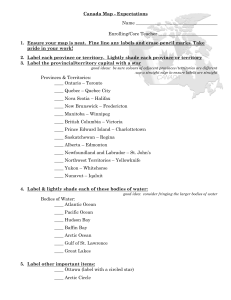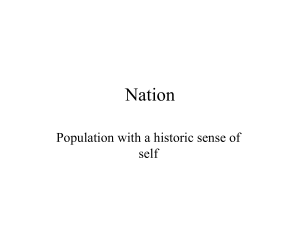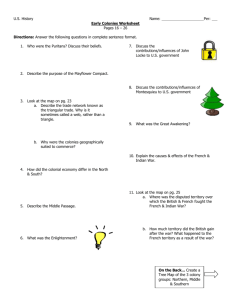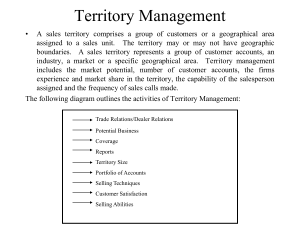Territory Design
advertisement
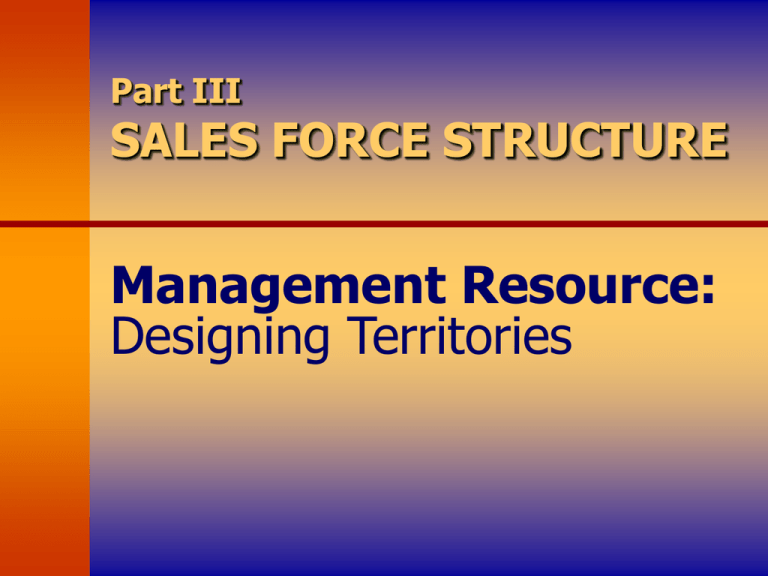
Part III SALES FORCE STRUCTURE Management Resource: Designing Territories Territory Design: Unbalanced Territories 2.0 Workload Across Sales Territories 1.8 1.6 Actual Territory Workload Workload 1.4 +15% 1.2 1.0 Ideal Territory Workload 0.8 -15% 0.6 0.4 0.2 Territories Sorted by Workload Figure MR6-1: Unbalanced Territories for a Cosmetics Company Territory Design: Why Sales Increase 250 Sales Lost 170 Sales Gained 130 Sales lost by reducing size of large territories is more than offset by sales gained by increasing small territories. 90 500 750 1000 1250 Sales Potential in Territory ($000) NOTE: Each dot on the graph represents one territory 1500 Territory Design: Reasons for Realignment A change in sales force size A change in sales force structure Mergers and acquisitions Shifts in market opportunities Demographic shifts New Products Need to shake things up Figure MR6-2: Reasons for a Major Territory Territory Design: Process Events triggering sales territory adjustments: Mergers Division consolidation Division split Sales force turnover Plant relocations Product line changes 1 Select geographic control units 2 Decide on alignment objectives 3 Choose starting points 4 Combine control units adjacent to starting points 5 Make final adjustments 6 Assign salespeople to new territories Figure MR6-3: Territory Design Process Revise territory Boundaries to balance workload and potential Territory Design: Process Steps What are triggering events? The Buildup Method -- Six Steps (9-1) 1. Select control units Census tracts -- good for dividing cities Counties - convenient and data readily available 2. Choose starting points Salesperson’s home Large customer - cut transportation cost Big city - convenient for services Territory Design: Process Steps (Cont.) 3. Determine Allocation Criteria Territory balance -- effect on morale Customer balance - distribute commission Potential balance - share business growth Size balance - reduce transportation costs 4. Combine Adjacent Control Unit (9-3) 5. Compare Sales Territories Mountains, roads, population center locations? 6. Assign people to Sales Territories Territory Design: Common Geographic Control Units Countries Cities States or provinces Zip codes Counties Census tracts Metropolitan areas Customers Table MR6-1: Geographic Control Units Used in Territory Design Territory Design: Sample Alignment Metrics Pharmaceuticals: Doctor Specialty Counts Patient Volumes Epidemiology Data Influential Doctors Teaching Institutions Managed Care Org. Surgical Procedures Total Hospital Beds Health and Beauty Aids: Retail Outlets Store All Commodity Volume Call Activity Requirements Office Products: Number of White Collar Workers Office and Distribution Locations Headquarter Locations Number of Accounts Customer Types Diagnostic Equipment: Testing Volume Installed Machines Contract Information Building Materials: Housing Starts # of Architects, Builders, Contractors Projected Population Growth Territory Design: Kentucky The numbers in each county are population figures and are a measure of potential. OHIO INDIANA WEST VIRGINIA ILLINOIS VIRGINIA TENNESSEE Kentucky Counties, Major Cities, and Population Centers Figure MR6-4: Kentucky Counties, Major Cities, and Population Centers Territory Design: Three Kentucky Territories Major super highways Territory borders OHIO INDIANA WEST VIRGINIA Territory 2 Territory 3 ILLINOIS Territory 1 VIRGINIA TENNESSEE Three Kentucky Sales Territories Figure MR6-5: Three Kentucky Sales Territories Territory Design: Comparing Three Kentucky Territories Territory Potential as Measured by Population Number of Counties 1 1,124,897 47 2 1,129,290 27 3 1,131,137 43 Table MR6-2: Comparing Three Kentucky Sales Territories Territory Design: Dividing a Large Territory Figure MR6-4: Dividing a Large Territory Territory Design: What Would You Do? Conway was recently promoted to southeastern regional manager, overseeing four area salespeople. Part of his promotion was a transfer to Atlanta from Dallas. The southeastern region was the poorest performing region in the country. Prior to his move to Atlanta, Conway spent a month studying the southeastern region: its past performance, sales potential, and staff. After much consideration, he decided that the problem was in the territory alignment. The business climate was changing, but the territories were not changing with them. For example, there was one salesperson based in charlotte, North Carolina to cover Kentucky, South Carolina, and the burgeoning business in North Carolina. Conway felt that he needed one salesperson to cover North Carolina exclusively, and move south Carolina and Kentucky to other territories. Territory Design: What Would You Do? (Cont.) Conway concluded that he should realign three of the four salespeople and hire three new salespeople. Now he just had to convince company management of the soundness of his plan and get his three salespeople, none of whom would have to move, to buy in. He knew that management would be concerned about added costs in a poorly performing area, and that his salespeople would worry that their compensation potential would be threatened. As a first-time manager, he was torn on how he should approach the situation. Should he call a meeting with management, or submit a proposal? And, should he seek the salespeople’s opinions, so they feel that they were part of the decision process? If so, should he do this before or after his meeting with management? What do you think? Territory Design: In-class Exercise T-1 1. Why do companies redesign territories? 2. In this role play, what were the reasons for redesigning territories? 3. What problems are likely to arise when territories are redesigned? 4. Which salespeople are most likely to be resistant to change? Territory Design: In-class Exercise T-1 (Cont.) 5. What mistakes were made in territory realignment? 6. What options are available? 7. Should the company give in to Hughes and not change his territory? 8. What if seven other people in the district come to you asking for the same deal as Hughes? What do you tell them? Territory Design: Territory Assignment Study Results Candidate-Territory Fit: Obese Candidate Non-Obese Candidate 2.57* 3.85 Preference for not placing Candidate: Obese Candidate 40% Non-Obese Candidate 10% * The higher the mean, the more fit for the assignment (out of 7)



